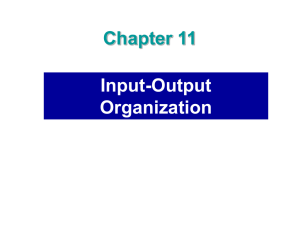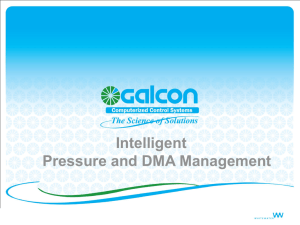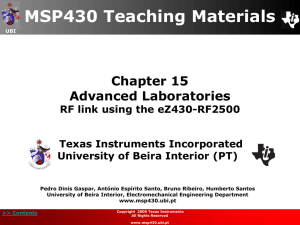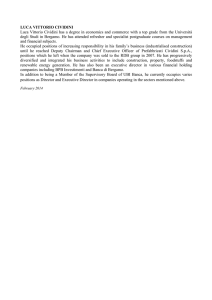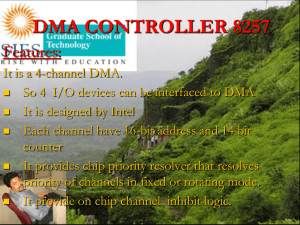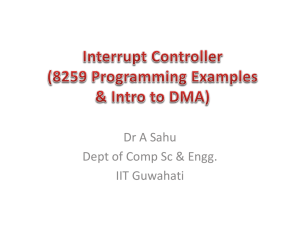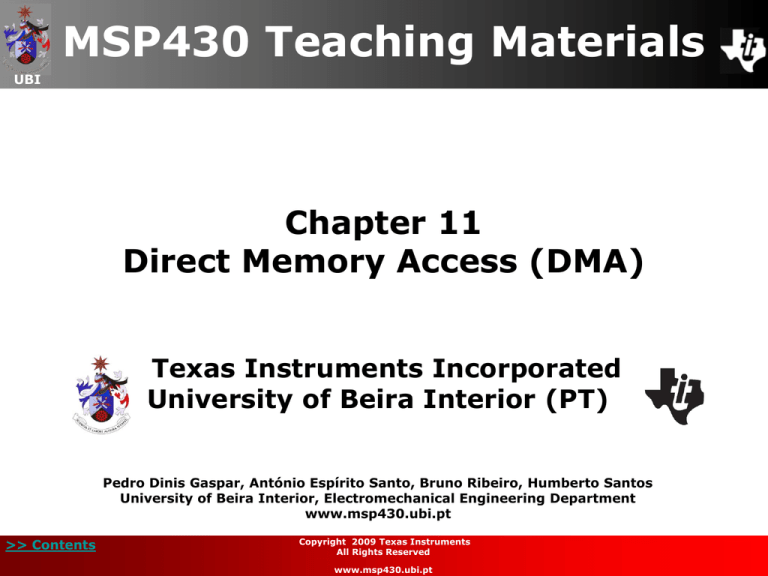
MSP430 Teaching Materials
UBI
Chapter 11
Direct Memory Access (DMA)
Texas Instruments Incorporated
University of Beira Interior (PT)
Pedro Dinis Gaspar, António Espírito Santo, Bruno Ribeiro, Humberto Santos
University of Beira Interior, Electromechanical Engineering Department
www.msp430.ubi.pt
>> Contents
Copyright 2009 Texas Instruments
All Rights Reserved
www.msp430.ubi.pt
Contents
UBI
Direct Memory Access (DMA) capability
DMA configuration and operation:
Block diagram
Features
System and DMA interrupts
DMA transfers
DMA Registers
Laboratory 7: Direct Memory Access:
Lab7A: Data Memory transfer triggered by software
Lab7B: Sinusoidal waveform generator
Quiz
>> Contents
Copyright 2009 Texas Instruments
All Rights Reserved
www.msp430.ubi.pt
2
DMA capability (1/3)
UBI
The MSP430 has been
requiring low power;
designed
for
applications
When the application requires data-handling, the direct
memory access (DMA) capability included in some
devices is useful:
5xxx; FG4xx(x); F261x; F16x(x) and F15x;
Among these: MSP430FG4618 (Experimenter’s board).
DMA automatically handles data;
DMA does not require CPU intervention;
DMA helps reduce the power consumption (CPU remains
sleeping).
>> Contents
Copyright 2009 Texas Instruments
All Rights Reserved
www.msp430.ubi.pt
3
DMA capability (2/3)
UBI
Concept of DMA: move functionality to peripherals:
Peripherals use less current than the CPU;
Delegating control to peripherals allows the CPU to shut
down (saves power);
“Intelligent” peripherals are more capable, providing a
better opportunity for CPU shutoff;
DMA can be enabled for repetitive data handling, increasing
the throughput of peripheral modules;
Minimal software requirements and CPU cycles.
>> Contents
Copyright 2009 Texas Instruments
All Rights Reserved
www.msp430.ubi.pt
4
DMA capability (3/3)
UBI
The following TI Application Reports cover the use of the
DMA controller for different applications, with the aim of
lowering power consumption:
• Streamlining the mixed-signal path with the signal-chainon-chip MSP430F169 <slyt078.pdf>
• Interfacing the MSP430 with MMC/SD Flash Memory
Cards <slaa281b.pdf>
• Digital FIR Filter Design Using the MSP430F16x
<slaa228.pdf>
• Using the USCI I2C Master <slaa382.pdf>
>> Contents
Copyright 2009 Texas Instruments
All Rights Reserved
www.msp430.ubi.pt
5
DMA configuration and operation (1/9)
UBI
Block diagram:
>> Contents
Copyright 2009 Texas Instruments
All Rights Reserved
www.msp430.ubi.pt
6
DMA configuration and operation (2/9)
UBI
DMA controller features:
Three independent transfer channels;
Configurable (ROUNDROBIN bit) DMA channel priorities:
• Default: DMA0−DMA1−DMA2;
DMA Transfer cycle time:
• Requires only two MCLK clock cycles per transfer;
• Each byte/word transfer requires:
– 2 MCLK cycles after synchronization;
– 1 MCKL cycle of wait time after transfer.
>> Contents
Copyright 2009 Texas Instruments
All Rights Reserved
www.msp430.ubi.pt
7
DMA configuration and operation (3/9)
UBI
DMA controller features:
Block sizes up to 65535 bytes or words;
Configurable edge/level-triggered transfer (DMALEVEL bit).
Byte or word and mixed byte/word transfer capability:
• Byte-to-byte;
• Word-to-word;
• Byte-to-word (upper byte of the destination word is
cleared);
• Word-to-byte (lower byte of the source word is
transferred).
>> Contents
Copyright 2009 Texas Instruments
All Rights Reserved
www.msp430.ubi.pt
8
DMA configuration and operation (4/9)
UBI
DMA controller features:
Four addressing modes for each DMA channel are
independently configurable (DMASRCINCRx and
DMADSTINCRx control bits):
• Fixed address to fixed address;
• Fixed address to block of addresses;
• Block of addresses to fixed address;
• Block of addresses to block of addresses.
>> Contents
Copyright 2009 Texas Instruments
All Rights Reserved
www.msp430.ubi.pt
9
DMA configuration and operation (5/9)
UBI
DMA controller features:
Six transfer modes (each channel is individually configurable
by the DMADTx bits):
DMADTx
Transfer mode
Description
DMAEN after
transfer
000
Single transfer
Each transfer requires a trigger
0
001
Block transfer
010, 011
Burst-block transfer
100
101
110, 111
>> Contents
Repeated single
transfer
Repeated block
transfer
Repeated burst-block
transfer
A complete block is transferred
with one trigger
CPU activity is interleaved with a
block transfer
Each transfer requires a trigger
A complete block is transferred
with one trigger
CPU activity is interleaved with a
block transfer
Copyright 2009 Texas Instruments
All Rights Reserved
www.msp430.ubi.pt
0
0
1
1
1
10
DMA configuration and operation (6/9)
UBI
System interrupts:
DMA transfers are not interruptible by system interrupts, but
system ISRs can be interrupted by DMA transfers;
Only NMI interrupts can be given priority over the DMA
controller (ENNMI bit is set). If the ENNMI bit is not set,
system interrupts remain pending until the completion of the
transfer.
DMA controller interrupts:
Each DMA channel has its own DMAIFG flag that is set when
the corresponding DMAxSZ register counts to zero (all
modes);
If the corresponding DMAIE and GIE bits are set, an
interrupt request is generated.
>> Contents
Copyright 2009 Texas Instruments
All Rights Reserved
www.msp430.ubi.pt
11
DMA configuration and operation (7/9)
UBI
DMA controller interrupts:
The MSP430FG4618 implements the interrupt vector register
DMAIV;
All DMAIFG flags are prioritized and combined to source a
single interrupt vector;
DMAIV is used to determine which flag requested an
interrupt.
>> Contents
Copyright 2009 Texas Instruments
All Rights Reserved
www.msp430.ubi.pt
12
DMA configuration and operation (8/9)
UBI
DMA transfers:
USCI_B I2C module with DMA:
• Two trigger sources for the DMA controller;
• Triggers a transfer when new I2C data is received and
when data is required for transmit.
ADC12 with DMA:
• Automatically moves data from any ADC12MEMx register
to another location.
DAC12 with DMA:
• Automatically moves data to the DAC12_xDAT register.
>> Contents
Copyright 2009 Texas Instruments
All Rights Reserved
www.msp430.ubi.pt
13
DMA configuration and operation (9/9)
UBI
DMA transfers:
DMA with flash memory:
• Automatically moves data to the Flash memory;
• Performs the data move data word/byte to the Flash;
• The write timing control is done by the Flash controller;
• Write transfers to the Flash memory succeed if the Flash
controller set-up is done before the DMA transfer and if
the Flash is not busy.
All DMA transfers:
• Occur without CPU intervention;
• Operate independently of any low-power modes;
• Increase throughput of modules.
>> Contents
Copyright 2009 Texas Instruments
All Rights Reserved
www.msp430.ubi.pt
14
DMA Registers (1/11)
UBI
DMACTL0, DMA Control Register 0 (FG4618)
15
14
13
12
11
Reserved
7
6
0001
0010
>> Contents
8
5
4
3
2
1
0
DMA0TSELx
All DMAxTSELx registers are the same.
DMAxTSELx
0000
9
DMA2TSELx
DMA1TSELx
10
Transfer triggered
when DMAREQ = 1
(DMAREQ = 0 automatically when the transfer starts)
<Timer_A> when TACCR2 CCIFG = 1
(CCIFG = 0 automatically when the transfer starts)
If CCIE = 1, CCIFG won’t trigger a transfer
<Timer_B> when TBCCR2 CCIFG = 1
(CCIFG = 0 automatically when the transfer starts)
If CCIE = 1, CCIFG won’t trigger a transfer
Copyright 2009 Texas Instruments
All Rights Reserved
www.msp430.ubi.pt
15
DMA Registers (2/11)
UBI
DMACTL0, DMA Control Register 0 (FG4618) (continued)
DMAxTSELx
0011
0100
0101
>> Contents
Transfer triggered
<USART0>:
when URXIFG0 = 1
(URXIFG0 = 0 automatically when the transfer starts)
If URXIE0 = 1, URXIFG0 flag won’t trigger a transfer
<USCI_A0>:
when UCA0RXIFG = 1
(UCA0RXIFG = 0 automatically when the transfer starts)
If UCA0RXIE = 1, UCA0RXIFG flag won’t trigger a transfer
<USART0>:
when UTXIFG0 =1
(UTXIFG0 = 0 automatically when the transfer starts)
If UTXIE0 = 1, UTXIFG0 flag won’t trigger a transfer
<USCI_A0>:
when UCA0TXIFG = 1
(UCA0TXIFG = 0 automatically when the transfer starts)
UCA0TXIE = 1, UCA0TXIFG flag won’t trigger a transfer
<DAC12> when DAC12_0CTL DAC12IFG = 1
(DAC12IFG = 0 automatically when the transfer starts)
If DAC12IE = 1, DAC12IFG won’t trigger a transfer
Copyright 2009 Texas Instruments
All Rights Reserved
www.msp430.ubi.pt
16
DMA Registers (3/11)
UBI
DMACTL0, DMA Control Register 0 (FG4618) (continued)
DMAxTSELx
0110
0111
1000
1001
>> Contents
Transfer triggered
<ADC12> when ADC12IFGx = 1 (corresponding ADC12IFGx flag for
single-channel conversions, and the ADC12IFGx for the last conversion for
sequence conversions)
(All ADC12IFGx = 0 automatically when the associated ADC12MEMx
register is accessed by the DMA controller)
<Timer_A> when TACCR0 CCIFG = 1:
CCIFG = 0 automatically when the transfer starts
If CCIE = 1, CCIFG flag won’t trigger a transfer
<Timer_B> when TBCCR0 CCIFG = 1
(CCIFG = 0 automatically when the transfer starts)
If CCIE = 1, CCIFG won’t trigger a transfer
<USART1>:
when URXIFG1 = 1
(URXIFG1 = 0 automatically when the transfer starts)
If URXIE1 = 1, URXIFG0 flag won’t trigger a transfer
Copyright 2009 Texas Instruments
All Rights Reserved
www.msp430.ubi.pt
17
DMA Registers (4/11)
UBI
DMACTL0, DMA Control Register 0 (FG4618) (continued)
DMAxTSELx
1010
1011
1100
1101
1110
1111
>> Contents
Transfer triggered
<USART1>:
when UTXIFG1 =1
(UTXIFG1 = 0 automatically when the transfer starts)
If UTXIE1 = 1, UTXIFG0 flag won’t trigger a transfer
<Hardware Multiplier>
when the hardware multiplier is ready for a new operand
<USCI_B0>:
when UCB0RXIFG = 1
(UCB0RXIFG = 0 automatically when the transfer starts)
If UCB0RXIE = 1, UCB0RXIFG flag won’t trigger a transfer
<USCI_B0>:
when UCB0TXIFG = 1
(UCB0TXIFG = 0 automatically when the transfer starts)
UCB0TXIE = 1, UCB0TXIFG flag won’t trigger a transfer
when the DMAxIFG = 1:
DMA0IFG triggers channel 1
DMA1IFG triggers channel 2
DMA2IFG triggers channel 0
(None of the DMAxIFG = 0 automatically when the transfer starts)
When an external trigger DMAE0 = 1
Copyright 2009 Texas Instruments
All Rights Reserved
www.msp430.ubi.pt
18
DMA Registers (5/11)
UBI
DMACTL1, DMA Control Register 1 (FG4618)
15
14
13
12
11
10
9
8
0
0
0
0
0
0
0
0
1
ROUNDROBIN
0
ENNMI
7
6
5
4
3
0
0
0
0
0
Bit
2
DMAONFETCH
1
ROUNDROBIN
0
ENNMI
>> Contents
2
DMAONFETCH
Description
DMA on fetch:
DMAONFETCH = 0 DMA transfer occurs immediately
DMAONFETCH = 1 DMA transfer occurs on next instruction fetch after
the trigger
Round robin:
ROUNDROBIN = 0 DMA channel priority is DMA0 − DMA1 − DMA2
ROUNDROBIN = 1 DMA channel priority changes with each transfer
Enable NMI when ENNMI = 1, allowing NMI interrupt to interrupt a DMA
transfer
Copyright 2009 Texas Instruments
All Rights Reserved
www.msp430.ubi.pt
19
DMA Registers (6/11)
UBI
DMAxCTL, DMA Channel x Control Register (FG4618)
15
14
Reserved
7
DMADSTBYTE
Bit
14-12
12
11
DMADTx
6
DMASRCBYTE
DMADTx
>> Contents
13
10
9
DMADSTINCRx
5
DMALEVEL
4
3
2
DMAEN
DMAIFG
DMAIE
Description
DMA transfer mode:
DMADT2 DMADT1 DMADT0
DMADT2 DMADT1 DMADT0
DMADT2 DMADT1 DMADT0
DMADT2 DMADT1 DMADT0
DMADT2 DMADT1 DMADT0
DMADT2 DMADT1 DMADT0
DMADT2 DMADT1 DMADT0
transfer
DMADT2 DMADT1 DMADT0
transfer
=
=
=
=
=
=
=
DMASRCINCRx
1
DMAABORT
0
DMAREQ
Single transfer
Block transfer
Burst-block transfer
Burst-block transfer
Repeated single transfer
Repeated block transfer
Repeated burst-block
= 111 Repeated burst-block
Copyright 2009 Texas Instruments
All Rights Reserved
www.msp430.ubi.pt
000
001
010
011
100
101
110
8
20
DMA Registers (7/11)
UBI
DMAxCTL, DMA Channel x Control Register (FG4618)
(continued)
15
14
Reserved
7
DMADSTBYTE
Bit
11-10
12
11
DMADTx
6
DMASRCBYTE
DMADSTINCRx
>> Contents
13
10
DMADSTINCRx
5
DMALEVEL
4
3
2
DMAEN
DMAIFG
DMAIE
9
8
DMASRCINCRx
1
DMAABORT
0
DMAREQ
Description
DMA destination address increment/decrement after each byte
or word transfer:
When DMADSTBYTE = 1, the destination address increments /
decrements by one
When DMADSTBYTE = 0, the destination address increments/
decrements by two.
DMADSTINCR1 DMADSTINCR0 = 00 Address unchanged
DMADSTINCR1 DMADSTINCR0 = 01 Address unchanged
DMADSTINCR1 DMADSTINCR0 = 10 Address decremented
DMADSTINCR1 DMADSTINCR0 = 11 Address increment
Copyright 2009 Texas Instruments
All Rights Reserved
www.msp430.ubi.pt
21
DMA Registers (8/11)
UBI
DMAxCTL, DMA Channel x Control Register (FG4618)
(continued)
15
14
Reserved
7
DMADSTBYTE
Bit
9-8
12
11
DMADTx
6
DMASRCBYTE
DMASRCINCRx
>> Contents
13
10
DMADSTINCRx
5
DMALEVEL
4
3
2
DMAEN
DMAIFG
DMAIE
9
8
DMASRCINCRx
1
DMAABORT
0
DMAREQ
Description
DMA source address increment/decrement after each byte or
word transfer:
When DMASRCBYTE = 1, the source address
increments/decrements by one
When DMASRCBYTE = 0, the source address
increments/decrements by two.
DMASRCINCR1 DMASRCINCR0 = 00 Address unchanged
DMASRCINCR1 DMASRCINCR0 = 01 Address unchanged
DMASRCINCR1 DMASRCINCR0 = 10 Address decremented
DMASRCINCR1 DMASRCINCR0 = 11 Address increment
Copyright 2009 Texas Instruments
All Rights Reserved
www.msp430.ubi.pt
22
DMA Registers (9/11)
UBI
DMAxCTL, DMA Channel x Control Register (FG4618)
(continued)
15
14
Reserved
7
DMADSTBYTE
13
11
DMADTx
6
DMASRCBYTE
Bit
7
DMADSTBYTE
6
DMASRCBYTE
5
DMALEVEL
4
3
2
1
DMAEN
DMAIFG
DMAIE
DMAABORT
0
DMAREQ
>> Contents
12
10
DMADSTINCRx
5
DMALEVEL
4
3
2
DMAEN
DMAIFG
DMAIE
9
8
DMASRCINCRx
1
DMAABORT
0
DMAREQ
Description
DMA destination length (byte or word):
DMADSTBYTE = 0
Word
DMADSTBYTE = 1
Byte
DMA source length (byte or word):
DMASRCBYTE = 0
Word
DMASRCBYTE = 1
Byte
DMA level:
DMALEVEL = 0
Edge sensitive trigger (rising edge)
DMALEVEL = 1
Level sensitive trigger (high level)
DMA enable when DMAEN = 1
DMA interrupt flag DMAIFG = 1 when interrupt pending
DMA interrupt enable when DMAIE = 1
DMA Abort DMAABORT = 1 when a DMA transfer is interrupted
by NMI
DMA request DMAREQ = 1 starts DMA
Copyright 2009 Texas Instruments
All Rights Reserved
www.msp430.ubi.pt
23
DMA Registers (10/11)
UBI
DMAxSA, DMA Source Address Register (FG4618)
32-bit register points to the DMA source address for single
transfers or the first source address for block transfers.
DMAxDA, DMA Destination Address Register (FG4618)
32-bit register points to the DMA destination address for
single transfers or the first source address for block
transfers.
>> Contents
For both registers (DMAxSA and DMAxDA):
• Bits 31−20 are reserved and always read as zero;
• Reading or writing to bits 19-16 requires the use of
extended instructions;
• When writing to DMAxSA or DMAxDA with word
instructions, bits 19-16 are cleared.
Copyright 2009 Texas Instruments
All Rights Reserved
www.msp430.ubi.pt
24
DMA Registers (11/11)
UBI
DMAxSZ, DMA Size Address Register (FG4618)
The 16-bit DMA size address register defines the number of
bytes/words of data per block transfer:
• DMAxSZ decrements with each word or byte transfer;
• When DMAxSZ = 0, it is immediately and automatically
reloaded with its previously initialized value.
DMAIV, DMA Interrupt Vector Register (FG4618)
16 bit DMAIV value only uses bits 3 to 1 (other bits = 0);
DMAIV content provides the interrupt source priority:
DMAIV = 02h: DMA channel 0 (highest priority);
DMAIV = 04h: DMA channel 1;
DMAIV = 06h: DMA channel 2;
…
DMAIV = 0Eh: Reserved (lowest priority).
>> Contents
Copyright 2009 Texas Instruments
All Rights Reserved
www.msp430.ubi.pt
25
Lab7: Direct Memory Access
UBI
Objective:
Configure the MSP430FG4618 device of the Experimenter’s
board to implement applications to transfer data without
using the CPU.
Details:
Similar to the previous exercise (Lab6), this laboratory is
composed of a series of sub-tasks.
>> Contents
This laboratory has been developed for the Code Composer
Essentials version 3 software development tool only.
Copyright 2009 Texas Instruments
All Rights Reserved
www.msp430.ubi.pt
26
Lab7: Direct Memory Access
Lab7A: Data Memory transfer triggered by software
UBI
Project files:
C source files:Chapter 11 > Lab7 > Lab7A_student.c
Solution files: Chapter 11 > Lab7 > Lab7A_solution.c
Overview:
During this laboratory, analysis is performed of the data
transfer between two regions of memory. The transfer is
carried out under the control of software.
A. Resources:
The following resource is used in this laboratory:
• DMA controller.
>> Contents
Copyright 2009 Texas Instruments
All Rights Reserved
www.msp430.ubi.pt
27
Lab7: Direct Memory Access
Lab7A: Data Memory transfer triggered by software
UBI
B. Organization of the software application:
Disable the watchdog timer;
Port P2.1 is set as an output at logic level low;
Data vector memory addresses are passed to the source
data address DMA0SA and destination address DMA0DA
registers;
The number of words to transfer is loaded into DMA0SZ;
The DMA channel 0 is configured to trigger the data
transfer by software (after each transfer, the destination
and source addresses are incremented);
Port P2.1 state is switched prior to initiating the data
transfer.
>> Contents
Copyright 2009 Texas Instruments
All Rights Reserved
www.msp430.ubi.pt
28
Lab7: Direct Memory Access
Lab7A: Data Memory transfer triggered by software
UBI
C. System configuration:
DMA channel configuration:
The source and destination addresses of the data must be
loaded into their respective registers:
DMA0SA = _________________;
DMA0DA = _________________;
To move a total of 32 words, what is the value to write to
the size register?
DMA0SZ = _________________;
>> Contents
Copyright 2009 Texas Instruments
All Rights Reserved
www.msp430.ubi.pt
29
Lab7: Direct Memory Access
Lab7A: Data Memory transfer triggered by software
UBI
C. System configuration:
DMA channel configuration:
The DMA channel must be configured to transfer the word
under the control of software;
The source and destination addresses should be
incremented immediately after each transfer.
DMA0CTL = ________________;
>> Contents
Copyright 2009 Texas Instruments
All Rights Reserved
www.msp430.ubi.pt
30
Lab7: Direct Memory Access
Lab7A: Data Memory transfer triggered by software
UBI
D. Analysis of operation:
In Memory window, the addresses of data vectors Tab_1
and Tab_2 are displayed. The contents of these addresses
must be identified in memory;
Add a breakpoint to line 57 of code, corresponding to the
line of code that performs the port P2.1 state switch;
Execute the application, and whenever the breakpoint is
reached, the execution of the application will be
suspended. Observe the data being gradually transferred
from the source to the destination;
The data transfer is suspended once the 32 elements of the
source data vector have been transferred.
>> Contents
Copyright 2009 Texas Instruments
All Rights Reserved
www.msp430.ubi.pt
31
Lab7: Direct Memory Access
Lab7A: Data Memory transfer triggered by software
UBI
MSP-EXP430FG4618
SOLUTION
Using the DMA controller included in the MSP-EXP430FG4618 Development
Tool, analyse the data transfer between two regions of memory.
DMA channel configuration:
// Start block address:
DMA0SA = (void (*)( )) &tab_1;
// Destination block address:
DMA0DA = (void (*)( )) &tab_2;
DMA0SZ = 0x0020;
// Block size
DMA0CTL=DMADT_0 | DMASRCINCR_3 | DMADSTINCR_3 | DMAEN;
// Single transfer, DMA source and destination
// addresses increment, Enable DMA0
>> Contents
Copyright 2009 Texas Instruments
All Rights Reserved
www.msp430.ubi.pt
32
Lab7: Direct Memory Access
Lab7B: Sinusoidal signal generator
UBI
Project files:
C source files:Chapter 11 > Lab7 > Lab7B_student.c
Solution files: Chapter 11 > Lab7 > Lab7B_solution.c
Overview:
This laboratory uses the DMA controller to automatically
transfer data between data memory and the DAC12 data
register. Thus, a sinusoidal signal is produced, without CPU
intervention.
A. Resources:
This laboratory uses the following peripherals:
• DMA controller;
• DAC;
• ADC (reference generator: VREF+);
• Timer_A;
• Low power mode.
>> Contents
Copyright 2009 Texas Instruments
All Rights Reserved
www.msp430.ubi.pt
33
Lab7: Direct Memory Access
Lab7B: Sinusoidal signal generator
UBI
B. Organization of the software application:
The successive samples needed to produce the sinusoidal
waveform from the DAC are stored in the data vector
Sin_tab, which has 32 points;
The software begins by disabling the watchdog timer,
followed by activating the internal reference voltage VREF+;
The source and destination registers of the data to be
transferred by the DMA channel are loaded with the data
vector Sin_tab address and with the DAC12 data register
address;
There are 32 data values to transfer.
>> Contents
Copyright 2009 Texas Instruments
All Rights Reserved
www.msp430.ubi.pt
34
Lab7: Direct Memory Access
Lab7B: Sinusoidal signal generator
UBI
B. Organization of the software application:
The data transfer is initiated whenever the flag DAC12IFG
is enabled;
It is a condition that for the data transfer to occur, the DAC
interrupt is not enabled;
The DMA controller is configured to perform in repeat mode
and to transfer a word whenever the previous event
occurs;
The data source address is set to increment after each
transfer, while the destination address must remain
constant.
>> Contents
Copyright 2009 Texas Instruments
All Rights Reserved
www.msp430.ubi.pt
35
Lab7: Direct Memory Access
Lab7B: Sinusoidal signal generator
UBI
B. Organization of the software application:
The timer is configured to generate the PWM signal
through the capture/compare unit TACCR1;
SMCLK is the clock signal that will be used to count up to
the value in the TACCR0 register;
Finally, the settings and interrupts are enabled and the
device enters into low power mode LPM0.
>> Contents
Copyright 2009 Texas Instruments
All Rights Reserved
www.msp430.ubi.pt
36
Lab7: Direct Memory Access
Lab7B: Sinusoidal signal generator
UBI
C. System configuration:
DAC12 reference voltage activation:
The DAC12 requires a reference voltage;
One of the options is to use the internal voltage VREF+;
Set the ADC12CTLO register to activate this voltage:
ADC12CTL0 =____________________;
>> Contents
Copyright 2009 Texas Instruments
All Rights Reserved
www.msp430.ubi.pt
37
Lab7: Direct Memory Access
Lab7B: Sinusoidal signal generator
UBI
C. System configuration:
DMA Controller configuration:
Configure the registers DMA0SA, DMA0DA and DMA0SZ to
transfer 32 words between the vector Sin_tab and
DAC12_0DAT data register:
DMA0SA = ______________________;
DMA0DA = ______________________;
DMA0SZ = ______________________;
Configure the register DMACTL0 to provide a data transfer
whenever the flag DAC12IFG is set:
DMACTL0 = _____________________;
>> Contents
Copyright 2009 Texas Instruments
All Rights Reserved
www.msp430.ubi.pt
38
Lab7: Direct Memory Access
Lab7B: Sinusoidal signal generator
UBI
C. System configuration:
DMA Controller configuration:
Configure the register DMA0CTL to carry out a repeat
simple transfer, incrementing the data source address:
DMA0CTL = _____________________;
>> Contents
Copyright 2009 Texas Instruments
All Rights Reserved
www.msp430.ubi.pt
39
Lab7: Direct Memory Access
Lab7B: Sinusoidal signal generator
UBI
C. System configuration:
Setup DAC12:
The DAC12 will update its output whenever there is
activation of the signal TA1;
The DAC full-scale should be 1x reference voltage;
Choose a medium relationship between the current and
average conversion speed of the DAC:
DAC12_0CTL = __________________;
>> Contents
Copyright 2009 Texas Instruments
All Rights Reserved
www.msp430.ubi.pt
40
Lab7: Direct Memory Access
Lab7B: Sinusoidal signal generator
UBI
C. System configuration:
Timer_A configuration:
The Timer_A is responsible for synchronizing data transfer
between memory and DAC12;
The Timer_A input receives as the SMCLK signal (1.048576
MHz) and must have a 30 msec counting period;
What value needs to be written to TACCR0 in order to
achieve this counting period:
TACCR0 = _______________________;
TACTL =_________________________;
>> Contents
Copyright 2009 Texas Instruments
All Rights Reserved
www.msp430.ubi.pt
41
Lab7: Direct Memory Access
Lab7B: Sinusoidal signal generator
UBI
C. System configuration:
Timer_A configuration:
The capture/compare unit TACCR1 should generate a PWM
signal in set/reset mode;
Configure the unit appropriately:
TACCTL1 = ______________________;
TACCR1 = _______________________;
>> Contents
Copyright 2009 Texas Instruments
All Rights Reserved
www.msp430.ubi.pt
42
Lab7: Direct Memory Access
Lab7B: Sinusoidal signal generator
UBI
D. Analysis of operation
>> Contents
The verification of this laboratory is performed by using an
oscilloscope to monitor the output of the DAC12 Channel 0,
available on header 8 pin 6.
Copyright 2009 Texas Instruments
All Rights Reserved
www.msp430.ubi.pt
43
Lab7: Direct Memory Access
Lab7B: Sinusoidal signal generator
UBI
MSP-EXP430FG4618
SOLUTION
Using the DMA controller included in the MSP-EXP430FG4618 Development
Tool, transfer a sinusoidal waveform to the DAC.
DMA Controller configuration:
// Source block address:
DMA0SA = (void (*)( ))&Sin_tab;
// Destination single address:
DMA0DA = (void (*)( ))&DAC12_0DAT;
// Block size:
DMA0SZ = 0x20;
// DMA control register 0:
DMACTL0 = DMA0TSEL_5;
>> Contents
Copyright 2009 Texas Instruments
All Rights Reserved
www.msp430.ubi.pt
// DAC12IFG trigger
44
Lab7: Direct Memory Access
Lab7B: Sinusoidal signal generator
UBI
DMA Controller configuration:
DMA0CTL = DMADT_4 + DMASRCINCR_3 + DMAEN;
//
//
//
//
Repeated single transfer,
DMA source address increment,
since DMASRCBYTE = 0, the source address
increments by two (word-word)
>> Contents
Copyright 2009 Texas Instruments
All Rights Reserved
www.msp430.ubi.pt
45
Lab7: Direct Memory Access
Lab7B: Sinusoidal signal generator
UBI
Setup DAC12:
DAC12_0CTL = DAC12LSEL_2 | DAC12IR | DAC12AMP_5 |
DAC12IFG | DAC12ENC;
//
//
//
//
Rising edge of Timer_A.OUT1 (TA1),
DAC12 full-scale output: 1x reference voltage,
Input and output buffers: Medium freq./current,
Enable DAC12
>> Contents
Copyright 2009 Texas Instruments
All Rights Reserved
www.msp430.ubi.pt
46
Lab7: Direct Memory Access
Lab7B: Sinusoidal signal generator
UBI
Timer_A configuration:
TACCR0 = 32-1;
TACTL = TASSEL_2 | MC_1;
TACCTL1 = OUTMOD_3;
TACCR1 = 20;
>> Contents
//
//
//
//
Clock period of TACCR0
SMCLK, continuous mode
TACCR1 set/reset
TACCR1 PWM Duty Cycle
Copyright 2009 Texas Instruments
All Rights Reserved
www.msp430.ubi.pt
47
Quiz (1/4)
UBI
1. The DMA controller allows the system to:
(a) Move data from one location to another without CPU
intervention;
(b) Increase the throughput of peripheral modules;
(c) Reduce system power consumption by allowing the CPU to
remain in a low-power mode;
(d) All of above.
2. The upper byte of a byte-to-word transfer:
(a) Maintains the previous value;
(b) Is cleared;
(c) Is loaded with the same value as the lower byte;
(d) None of above.
>> Contents
Copyright 2009 Texas Instruments
All Rights Reserved
www.msp430.ubi.pt
48
Quiz (2/4)
UBI
3. When the DMA transfer mode DMAxTSELx = 1 is
selected:
(a) Each transfer requires a trigger;
(b) A complete block is transferred with one trigger;
(c) CPU activity is interleaved with a block transfer;
(d) None of above.
4. NMI interrupts can interrupt the DMA controller
when:
(a) GIE bit is set;
(b) DMAIE is set;
(c) ENNMI bit is set;
(d) DMAEN is set.
>> Contents
Copyright 2009 Texas Instruments
All Rights Reserved
www.msp430.ubi.pt
49
Quiz (3/4)
UBI
5. The DMA destination address when the
DMADSTBYTE = 1 and DMADSTINCRx = 3:
(a) Remains unchanged;
(b) Increments by two;
(c) Decrements by two;
(d) Increments by one.
6. For the default DMA channel priority
(DMA0−DMA1−DMA2), if ROUNDROBIN is cleared after
transferring DMA0, the next priority is:
(a) DMA2 − DMA0 − DMA1;
(b) DMA1 − DMA2 − DMA0;
(c) DMA0 − DMA1 − DMA2;
(d) DMA1 − DMA0 − DMA2.
>> Contents
Copyright 2009 Texas Instruments
All Rights Reserved
www.msp430.ubi.pt
50
Quiz (4/4)
UBI
Answers:
1. (d) All of above.
2. (b) Is cleared.
3. (b) A complete block is transferred with one trigger.
4. (c) ENNMI bit is set.
5. (d) Increments by one.
6. (c) DMA0 − DMA1 − DMA2.
>> Contents
Copyright 2009 Texas Instruments
All Rights Reserved
www.msp430.ubi.pt
51

